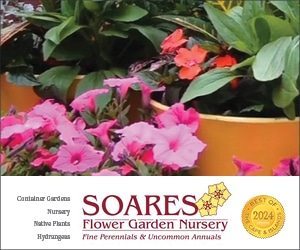
W: Water Feature
Cape Cod Home / Annual Home 2020 / Home, Garden & Design, Nature, People & Businesses
Writer: Elizabeth Shaw
W: Water Feature

Cape Cod Home / Annual Home 2020 / Home, Garden & Design, Nature, People & Businesses
Writer: Elizabeth Shaw
Gregory Lombardi Design

On Cape Cod, water is everywhere, be it the ocean, ponds or bays. But what if you wanted even more water in your life? Gregory Lombardi Design can help you bring the peace and tranquility of the Cape’s beautiful seaside into your own backyard. Since 1992, Gregory Lombardi Design has been creating award-winning outdoor spaces throughout New England. When crafting a new backyard landscape, many choose to incorporate intricate water features. From waterfalls to fountains to koi ponds, Gregory Lombardi Design can bring your vision to life.
The perfect waterscape starts with meticulous planning. “It’s all very customized and tailored for each client. We start by talking through the goals for the space, whether it’s a pond or water basin. Will it be a focal piece or a hidden little respite?” explains Troy Sober, ASLA, PLA, a Principal at Gregory Lombardi Design. Concept designs are created and supported by character images and the design is reworked until everyone is satisfied. That’s when the planning really begins. The landscape in question is evaluated for conditions that can help or hinder the design. “We need to take into consideration conditions that can be utilized or accentuated when creating a waterscape. It’s really all about the combination of the right materials and the right site that makes a water feature successful. While tailoring a piece to the client is crucial, it also requires working within the landscape,” explains Sober.
When considering a waterscape for your home, Sober says the main focus should be the goals for the feature. Waterscapes can serve many purposes on a residential property from a purely decorative fountain to a meditative retreat to a sustainable ecosystem. While it’s important to determine whether you want it to be low maintenance or sustainable and whether you want to incorporate locally sourced, salvaged materials, Sober says the most important questions are the practical ones: what kind of access do you have to water? If the feature is free standing, like a basin, can it be refueled? Is there access to electricity? How big will the feature be and how can environmental factors help or hinder its success? A Cambridge water feature will be much different than one in Chatham because there are multiple regionally appropriate components to work with.

Waterscapes aren’t just for show: they can add quite a few benefits to a property and serve various purposes. “Clients often like the calming, soothing qualities of moving water; they can increase enjoyment of the space, drawing you into the garden and often muting outside noise and traffic,” says Sober. Waterscapes provide homeowners with a place to sit and relax, to reflect and unwind. Emotional and mental benefits intersect with potential environmental perks as well. Sober further explains, “If you have enough room for a pond, it has significant environmental benefits. When positioned properly, it can collect water and filter it, as well as create a home for a variety of flora and fauna. Ponds are relatively low maintenance and quite sustainable. Additionally, the settled debris at the bottom can be used as fertilizer.” Gregory Lombardi Design has created ponds that are stocked with koi fish and ducks to create a wildlife getaway for the homeowners and to help manage algae in the pond. Some ponds have featured waterfalls that act as a natural filtration and aeration system.
That duality extends in unexpected places when it comes to fountain or basin waterscapes. Like the waterfall in the koi pond, fountains act as natural white noise, blocking out traffic or neighborhood noise. While they don’t create an ecosystem the way ponds do, they can be sustainably created using recycled and salvaged materials. The water basin shown in the top photo, opposite page, was created using a single, solid block of salvaged granite. “We had fun working with the masons at R.P. Marzilli to help carve the depth and shape of the basin. Having a native piece of stone delivered on site gave a little more of an agrarian feel to the final project,” says Sober. Also pictured is a home on Nantucket, with three spouts pouring into a basin. The limestone basin came from an antique dealer and was repurposed for the water feature. “The idea for that, from a design standpoint, was to create an opposing texture for the more modern landscape and wall stone. It then has three bronze spouts that recycle the water back through. It has become the focal point for the family entranceway,” Sober reflects about this Nantucket property.

The beauty of waterscapes comes from their unique purposes and styles. “I wouldn’t necessarily say there’s a particular trend in water feature style or design, but there is a trend towards sustainable design and materials. Many of the properties with water features are using it as an opportunity to collect water, filter it and create an amenity,” explains Sober. “Our clients are leaning towards smaller pieces as well, with a focus on locally sourced and salvaged materials for fountains and basins.” Whether you are looking for a small fountain accent or a backyard ecosystem, Gregory Lombardi Design can create a water feature that will enhance your landscape in more ways than one.
For more advice, tips and tricks, check out the rest of the alphabet here!



